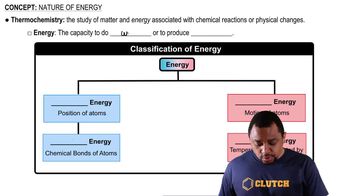Ch.22 - Chemistry of the Nonmetals

Brown15th EditionChemistry: The Central ScienceISBN: 9780137542970Not the one you use?Change textbook
Chapter 22, Problem 19
Complete the exercises below. a. Give the names and chemical symbols for the three isotopes of hydrogen. b. List the isotopes in order of decreasing natural abundance. c. Which hydrogen isotope is radioactive? d. Write the nuclear equation for the radioactive decay of this isotope.
 Verified step by step guidance
Verified step by step guidance1
Identify the three isotopes of hydrogen: Protium, Deuterium, and Tritium. Their chemical symbols are \(^1_1\text{H}\), \(^2_1\text{H}\), and \(^3_1\text{H}\) respectively.
List the isotopes in order of decreasing natural abundance: Protium (\(^1_1\text{H}\)), Deuterium (\(^2_1\text{H}\)), and Tritium (\(^3_1\text{H}\)).
Determine which isotope is radioactive: Tritium (\(^3_1\text{H}\)) is the radioactive isotope of hydrogen.
Understand the type of decay Tritium undergoes: Tritium undergoes beta decay, where a neutron is converted into a proton, emitting a beta particle (electron) and an antineutrino.
Write the nuclear equation for the decay of Tritium: \(^3_1\text{H} \rightarrow ^3_2\text{He} + \beta^- + \bar{\nu}_e\).
Key Concepts
Here are the essential concepts you must grasp in order to answer the question correctly.
Isotopes
Isotopes are variants of a chemical element that have the same number of protons but different numbers of neutrons, resulting in different atomic masses. For hydrogen, the three isotopes are protium (1H), deuterium (2H), and tritium (3H). Understanding isotopes is crucial for discussing their properties, abundance, and applications in various fields, including chemistry and nuclear physics.
Recommended video:
Guided course

Isotopes
Natural Abundance
Natural abundance refers to the relative proportion of each isotope of an element found in nature. For hydrogen, protium is the most abundant isotope, followed by deuterium, with tritium being rare and primarily produced artificially. Knowing the natural abundance of isotopes is important for applications in radiometric dating, nuclear medicine, and understanding elemental composition.
Recommended video:
Guided course

Nature of Energy
Radioactive Decay
Radioactive decay is the process by which an unstable atomic nucleus loses energy by emitting radiation, resulting in the transformation into a different element or isotope. Tritium (3H) is the only hydrogen isotope that is radioactive, decaying into helium-3 (3He) through beta decay. Writing the nuclear equation for this decay is essential for understanding nuclear reactions and the behavior of radioactive materials.
Recommended video:
Guided course

Rate of Radioactive Decay
Related Practice
